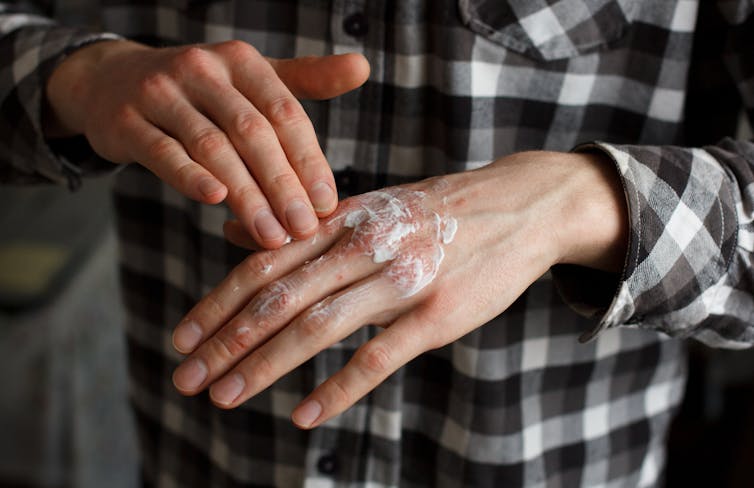Topical corticosteroids, also referred to as corticosteroids or cortisone, are the go-to treatment for many skin disorders including eczema, dermatitis and psoriasis. They can be found in various forms such as creams, ointments, and solutions.
These medications work by entering the skin cells and mimicking natural hormones, blocking inflammation and constricting blood vessels. Topical corticosteroids come in different strengths, from mild (such as 0.5% Hydrocortisone, available over the counter) to very potent prescription formulations.
But the way different people react to topical steroids can be unpredictable. While some people might get significant relief with short-term use, others could need continuous care.
So, how should you use cortisone creams and ointments? And why is there conflicting advice about their long-term use?
Read more: Health Check: why do we get dry skin in winter?
‘Use sparingly’
Patients are currently recommended to use cortisone formulations “sparingly” or “thinly”. But this can increase the risk they won’t work effectively. Treatment failure can add to “steroid phobia” and stop people getting the medication they need.
Such warnings ignore the fact many patients are prescribed modest-strength topical steroids, which are safe and effective when used properly. Adverse effects, such as when the formulations damage or irritate skin, are not typical.
From the patient’s perspective, the current warnings lump all steroids together regardless of their potential for side effects. Also, the advice tends to support false concerns: that topical and ingested (orally taken) corticosteroids carry the same dangers, which they do not.
Mixed messages
Should you use a weaker formulation for longer? Or hit the problem hard with a stronger concentration for less time?
At the moment, some treatment recommendations – such as for scalp psoriasis – say patients should use a high-dose cortisone formulation for four weeks and increase frequency of use if it’s not effective. If cortisone is extensively used, it is advised adults and children should be examined yearly for side effects.

Skin atrophy (or deterioration) is the most common side effect of topical corticosteroids and manifests as tiny degenerative alterations within a few weeks. The patient’s age, body site, cortisone potency and the existence of any coverings, all have an impact on the extent of skin damage.
Reduced skin cell growth, decreased collagen development and stimulation of tiny vessels and capillaries in the skin are the main features of such skin atrophy. Thinner skin, more moisture, higher temperatures, and partial blockage make areas where skin folds on the body (for example, the armpits, between fingers, the groin) particularly vulnerable. These are also often the sites of skin irritation needing treatment.
Skin thinning
Topical steroids cause the skin to reabsorb a type of connective tissue building block, called mucopolysaccharide ground material. Repeated use in the same spot on the body results in alterations to the skin’s connective tissue and epidermal thinning.
That can result in lax, translucent, wrinkled skin as well as striae (stretch marks), fragility, hypo-pigmentation (fading) and the prominence of underlying veins.
More research is needed to help specialists choose the best corticosteroids for a given condition. High-potency cortisone formulations, long-term use and sun exposure have been implicated in chronic fragile skin syndrome, which is increasingly common and features the symptoms outlined above.
However, if best practice guidelines are followed, these side effects can be reduced by using lowering the potency of corticosteroids and stopping treatment when the patient has fully recovered.
Corticosteroids should only be used for a maximum of three months. For some conditions, such as vitiligo, they need to be used for longer periods, so regularly taking several weeks’ break is advised.
The good news is that once topical corticosteroids are stopped, short-term atrophy from treatment can be reversed, although skin normalisation may take months.

Read more: Drugs and the sun – your daily medications could put you at greater risk of sunburn
Can you use it safely on your face?
Due to the substantial risk of steroid-induced skin deterioration, the guidelines recommend against using potent and very potent corticosteroids on the face, flexures (parts of the body that bend, such as elbows) or genitalia. So, mild to moderate-potency corticosteroids are the main treatment option.
Using strong cortisone creams or ointments on the face can lead to steroid dependence. Patients who are dependent on steroids and have acne, rosacea, perioral dermatitis or telangiectasia (widened blood vessels on the skin) continue to use the drug because they worry stopping the drug could worsen their condition.
Topical steroids on the face can cause symptoms sometimes referred to as “red face syndrome”, dermatitis rosaceaformis steroidica or steroid addiction. And stopping steroid use on the face after an extended period can have considerable rebound effects including erythema (redness), burning and scaling.
Read more: What is sodium lauryl sulfate and is it safe to use?
The bottom line
When used correctly, cortisone creams, ointments and lotions can be safe and effective.
Clear instructions could include estimating dosage in “fingertip units”, with a chart showing the number of units needed for various body parts, such as one unit to treat skin on an adult’s hand but seven units to treat skin on their back.
To avoid skin damage, corticosteroids should only be used on skin affected by a skin disease. Better education and information is needed to reflect the minimal risks from topical corticosteroids that are low to moderate strength and how important it is to use enough medication to treat a condition.
Finally, treatment should be customised based on the person’s symptoms, the body parts affected and how long treatment might be required.

